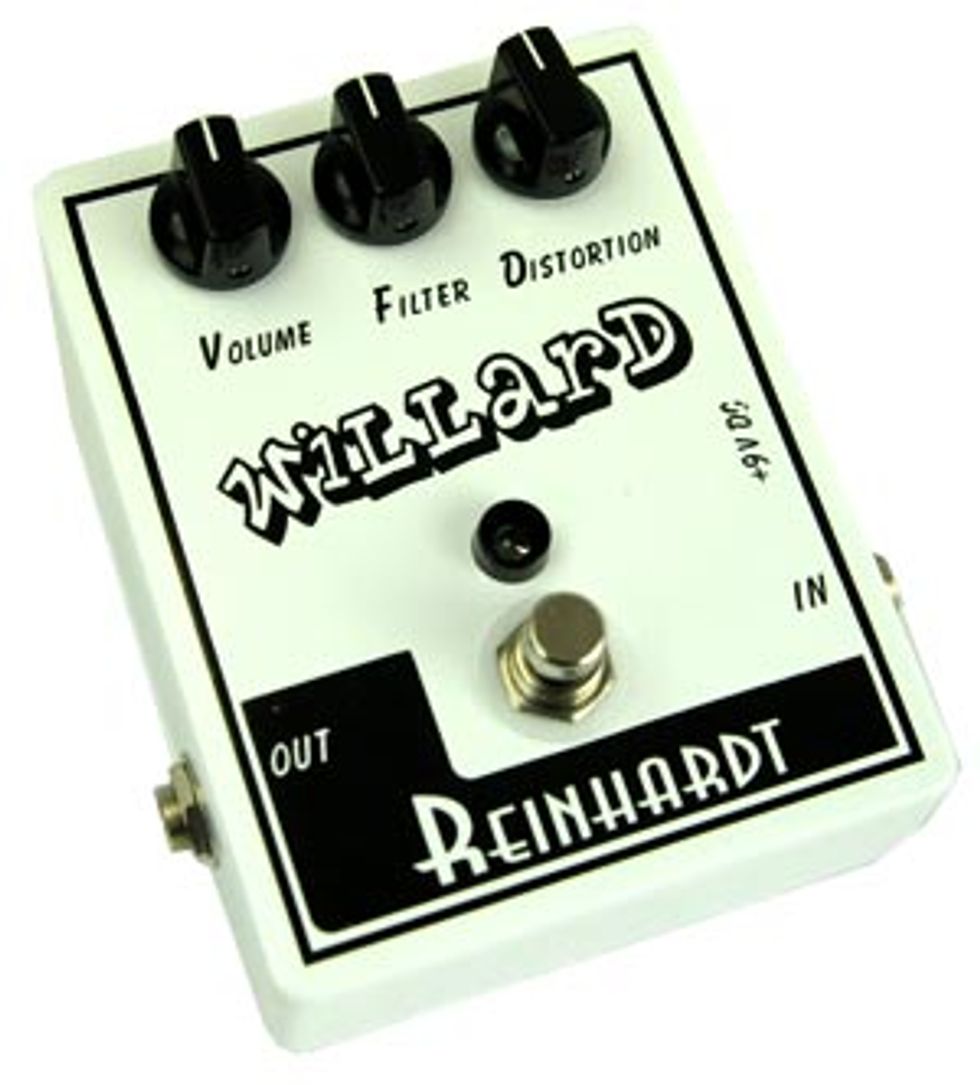The Willard is a high-gain distortion that channels old big-box Rat pedals
 | |
| Download Example 1 Cleaned up for rhythm chords | |
| Download Example 2 Full distortion lead (neck pup) | |
| Download Example 3 Full distortion lead (bridge pup) | |
| Download Example 4 Half gain | |
| Download Example 5 Halfway lead (neck pup) | |
| Download Example 6 Halfway lead (bridge pup) | |
| Clips recorded with Les Paul Custom through 1964 Vox AC 50 amp with two Celestion G12H speakers, no other effects | |
First Impressions
The controls are Volume, Filter, and Distortion. Input and output jacks are located on the sides, as is the 9-volt power jack. It features a true-bypass switch and a bright green LED. Opening it up and looking under the hood, we find a nicely assembled and cleanly wired circuit board featuring high-quality components. There is a socket-mounted chip for easy replacement should the need arise. I would have liked to have seen a better battery mounting system, as the battery rattled around inside the unit .
The manufacturer states that this pedal is similar to the old big-box Rat pedals of the past, with some NOS parts including the chip inside. Having personally owned many old Rat pedals, I think this comparison is pretty accurate. The Rat pedals that most players will be familiar with are the newer, small-box type. They seem to be quite fuzzy and harsh. This one is definitely not even similar to those types. The old pedal was more harmonically rich, sustained well and would clean up when the volume was turned down on the guitar. The Willard shares all of these characteristics and more.
How does it sound?
First of all I tested the pedal though several different types of amps—a Fender Deluxe, a Marshall 100-watt non-master '70s head and 4x12 cabinet, and my Vox Tube rectified AC50 with 2x12 cabinet. The guitars used were my trusty Les Paul Custom with old PAF neck pickup and Bare Knuckle Steve Stevens model bridge pickup. I also tested it with an American Standard Stratocaster.
Starting with all the knobs at 12:00, I found a nice rich distortion tone—not too heavy on the bass, and with great pick harmonics. I noticed that the level was not unity gain (which means that the volume of the pedal on was not even with the pedal in the off position.) A turn of the volume control eased my worries, as I found the greatest increase volume was between the three-quarter to full-up setting. As a matter of fact, it has more headroom than most pedals I have seen. This is a good thing because headroom equals a tight, solid tone with authority and note definition.
Notably, there was even more note definition than the old model had. Raising the level of the distortion control brought some pleasant surprises. At the three-quarter position of this control, huge distortion occurred. Not the big, bloaty distortion of the past units, but monster, killer, rocking tone. I was able to achieve awesome harmonics (a la Zack Wylde) while still being able to clean up well. The filter control was very effective in honing in on the perfect amount of brightness and overtones. It is much more than just a bass/treble control. In fact, I found it controlled the midrange resonance as well. Distortion on full was over-the-top. The guitars screamed with great low end and killer harmonic feedback. The Stratocaster produced some very Hendrix-like tones with this pedal.
The Final Mojo
I found the Reinhardt Willard pedal to be a great choice for those seeking powerful, massive distortion sounds without being too buzzy or fizzy. It works well with most all types of guitars, single-coil or humbuckers. It sounds good when played through either an amp set on clean or set on slight breakup. At lower settings it makes a great overdrive as well. I really liked this one. On note: when trying pedals of this type, be sure that the amp is turned up into its power range. If you try a distortion pedal at bedroom volume, the result will be a very muddy sound. You need headroom from the amp to tighten the sound, so crank it up to get a true representation of how the pedal sounds.
Buy if...
you are looking for a rocking distortion sound for your nice clean tube amp
Skip if...
you are looking for another T.S. overdrive circuit.
Rating...
MSRP $225 - Reinhardt Amps - reinhardtamps.com |
